Let’s face it, wherever you go it’s hard to avoid the subject of food. Indeed, shortly upon meeting me, people around here often ask: “O ja eng?” or “A o ja bogobe?” “What do you eat? Do you eat pap (the ubiquitous boiled corn-meal staple)?” And, of course, South Africans are far from alone: everyone loves food! So here’s your story on eating…the South African way.
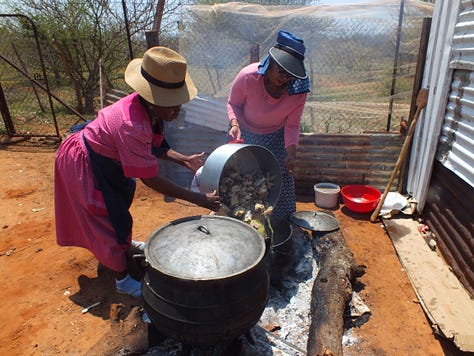

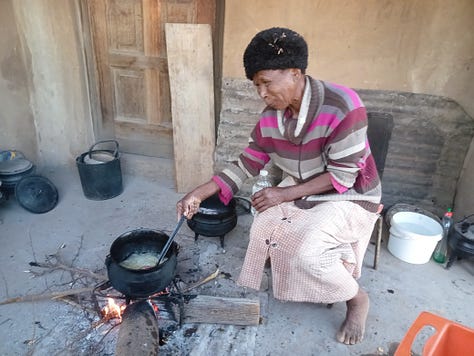
‘Dijo’ - food!
Unlike back home — where the answer to “what’s for dinner?” usually starts and often ends with the meat or heavy protein course: steak, roast chicken, stuffed trout, etc. — when talking about meals here it is usually the starch that is mentioned first: pap, samp, rice, etc., only after which might be added: with chicken, beef, beans, etc. I’ve noticed this in other places as well: the bulk of the meal is the carbohydrate course and the rest — the meat, vegetables, and the like — is considered secondary. Indeed, many countries and regions have become inextricably identified with their favorite high-energy repast: Mexico tortillas (corn or wheat); Italy pasta, East Asia rice; Ethiopia — injera (tef); West Africa, cocoyams; North Africa cous-cous, the South Pacific taro, and so forth. Clearly, here in South Africa as in much of the sub-Saharan region, maize or corn rules. Maize meal is typically boiled into a stiff porridge ‘pap’ (bogobe in Setswana) and served in hardy quantities alongside smaller portions of meat and vegetables; and, at least in the minds of about 60 million patriots, it is the real deal!
But it hasn’t always been this way. In fact for most of humankind’s lengthy tenure in Africa there was not a kernel of corn to be found — much in the way that Ireland had no potatoes, the great plains of North America lacked wheat, and Italy was without tomatoes (yes, even romas!). In those pre-Colombian days, people had to get by on what plants and animals were part of the heritage of their surroundings, and here a major staple was sorghum, which can be ground into flour much like wheat or rye. It wasn’t until the Portuguese — fresh off their exploits in the New World — brought maize (as well as cassava and potato) back to supply their burgeoning colonies that this grain appeared on the African scene. Certainly its origins amid the hot, humid conditions of Mesoamerica made corn a sound candidate for cultivation in sub-Saharan Africa. And it would take only a quick survey of this continent to reveal that, after 400-plus years, this marriage between the African people and Zea mays is still going strong.
However, maize pap isn’t the only item on offer here. In rural South Africa one still finds sorghum (served as pap or as a thinner porridge) as well as rice, samp (boiled cracked-corn kernels), potatoes and other starches on the plate — although none, as far as I can tell, can rival corn pap in popularity. Whatever the choice, the carbohydrate is usually paired with stewed or grilled meat (traditionally beef, chicken, goat), beans or fish and vegetables and — in the case of pap — eaten with the hands.
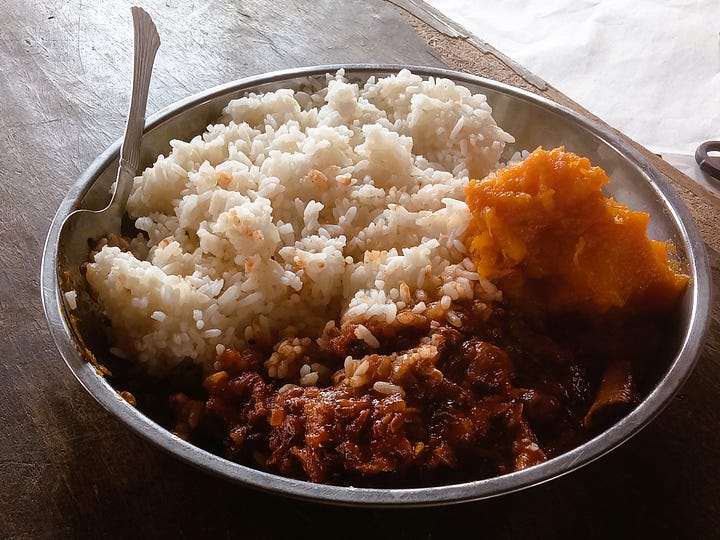



Some Tswana standards…
Bogobe (pap) normally served with meat (fish or beans) and often a vegetable: spinach (chard), morogo (local green), cabbage, squash, beets.
Ting (sour pap) — made of slightly fermented sorghum meal, which gives it a mildly tangy flavor, and served in the same manner as pap. This indigenous grain and its culinary derivatives have surely been a regional staple for ages. There is also a white (corn) version of ting.
Setampa (samp) — generally served with stewed meat or beans.
Rice with beans, meat or fish. Rice anchors the customary Sunday meal ‘seven colors’ that includes meats and various vegetables — chard, morogo, beets, butternut and others — which impart a festive air to the table.
Mala mogodu (tripe), tlhakwana, (cow heel) and maotwana (chicken feet), often grilled crispy (has a loyal following among some PCVs).
Braai — Boerwors (sausages) are popular in addition to the standard cuts of meat, especially beef.
Sides/garnishes: chakalaka — sauteed onions, peppers, carrot, cabbage and beans — in tomato sauce and generally served at room temperature; and atcha: shredded mango (the entire fruit is used) marinated in savory oil; some versions feature cabbage or other veggies.
Cooking the Peace Corps way…
I’ve often likened the Peace Corps volunteer experience to being somewhere between life back home and a two year camping trip; where you land on this continuum depends on many factors including your country of service, location within that country, climate, access to transportation, markets and basic infrastructure (electricity, running water). As for me, my circumstances put me perhaps a little closer to the home-life end of the spectrum, though there are certainly some notable concessions that living here has required. One is the non-constant supply of electricity; but power outages are typically scheduled (each day at 5:00-7:00 am and pm), so that makes it easier to establish a routine around cooking and food preparation. With the refrigerator going on and off twice a day, I tend to abstain from foods that spoil quickly or I buy them in small quantities.
Proximity to markets — especially when having to rely on public transportation — is another major determinant in what we eat. I’m lucky to have a supermarket in my town; however I still need to lug sacs of groceries a few hundred meters from the taxi stop to my place — so extravagant, bulk, and glass-bottled items tend to be left off of the shopping list. Also, heat: who wants to spend afternoons cooking in 35-plus degrees C. (even hotter inside)? And then there is clean-up: without such luxuries as indoor plumbing, hot water, garbage disposals, and rubbish pick-up, I tend to avoid meals that involve really messy preparations or excess waste (whole chickens, seafood, deep-fried foods, etc.). My kitchen is simple — lacking many of the familiar appliances of home (not the least of which is an oven) — but that is no impediment to cooking and eating well and, at times, even having fun in the process.
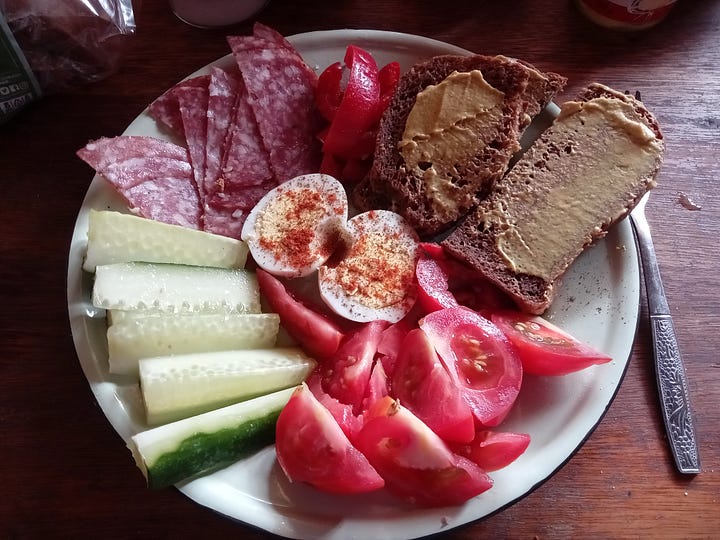
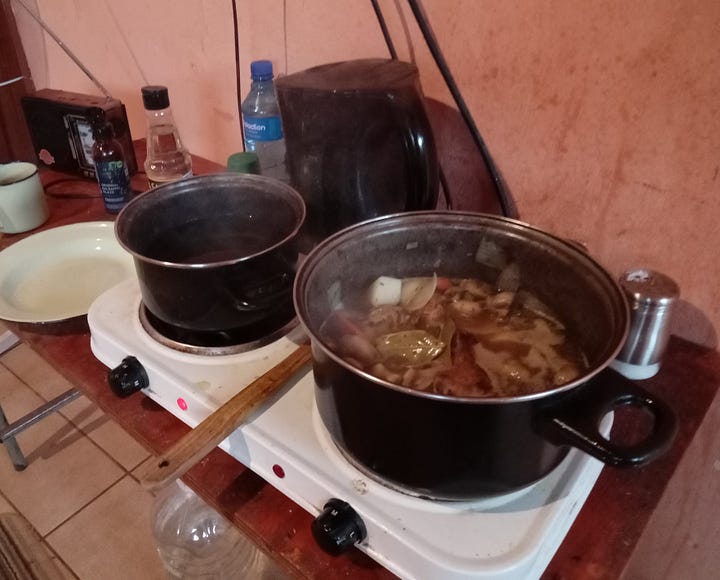
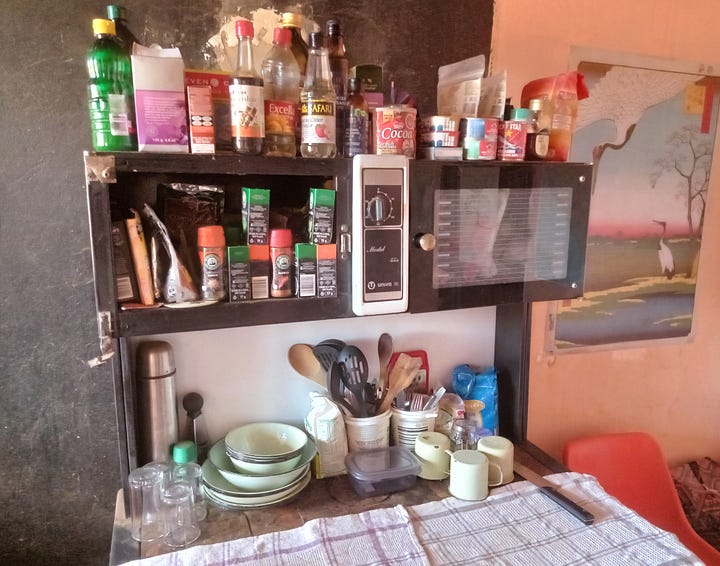

So what is on my plate?
Typical dinners:
Chicken stew — traditional or variants such as in mafe (West African groundnut stew); this can be prepared in advance and enjoyed over two or three meals, and the cat loves the skin and bones.
Dahl — lentils South Asian style. Fresh, high quality Indian spices abound here, making this dish a consistent winner.
Pasta marinara, sometimes puttanesca — the abundance of fresh tomatoes and peppers makes this an easy choice. In the absence of anchovies, locally available dried fish bolsters the base.
Split pea soup (more frequent in the cooler months) — practical and yields several meals.
Sauteed or lemon/butter poached fish (hake) — easy, delicious and it drives the cat crazy waiting for a handout.
Pork chops (dry-rub) and onions — quick, easy and kitty relishes the trimmings (sometimes it feels like I’m cooking for two…).
Samp or rice with beans — the need for extended pre-soaking (samp and beans) makes this one less convenient.
Stir-fry chicken — lots of peppers, mushrooms, onions with rice or some fancier grain that I pick up in market towns (less frequent during power rationing).
‘Heavy’ salad — with protein such as sardine, tuna, left-over meat, cheese, hard-boiled egg — this one is especially welcome towards the end of the week or during extended power outages.
Sides: lots of potato salad, green salads (iceberg); steamed or sauteed veggies such as broccoli, cabbage, chard or green-beans; some butternut, beets, etc.

Snacks:
Without a steady supply of power and familiar kitchen conveniences such as a toaster and microwave, you tend to favor easy, high-impact snacks. To that end, I’ve been eating a LOT of the following and likely will give some of them a rest once I’m back stateside: peanuts, hard-boiled eggs, sardines, cheese (including the timeless standard pictured above), peanut butter, apples, bananas, avocados, yogurt and Cadbury bars…and, of course, lots of tea of various blends.
It may not look fancy or ever make the cover of Bon Appetite magazine — but after more than a year here in South Africa — I’m happy to report that the diet has been treating me just fine.
‘Ja sentle’ — enjoy your next meal!




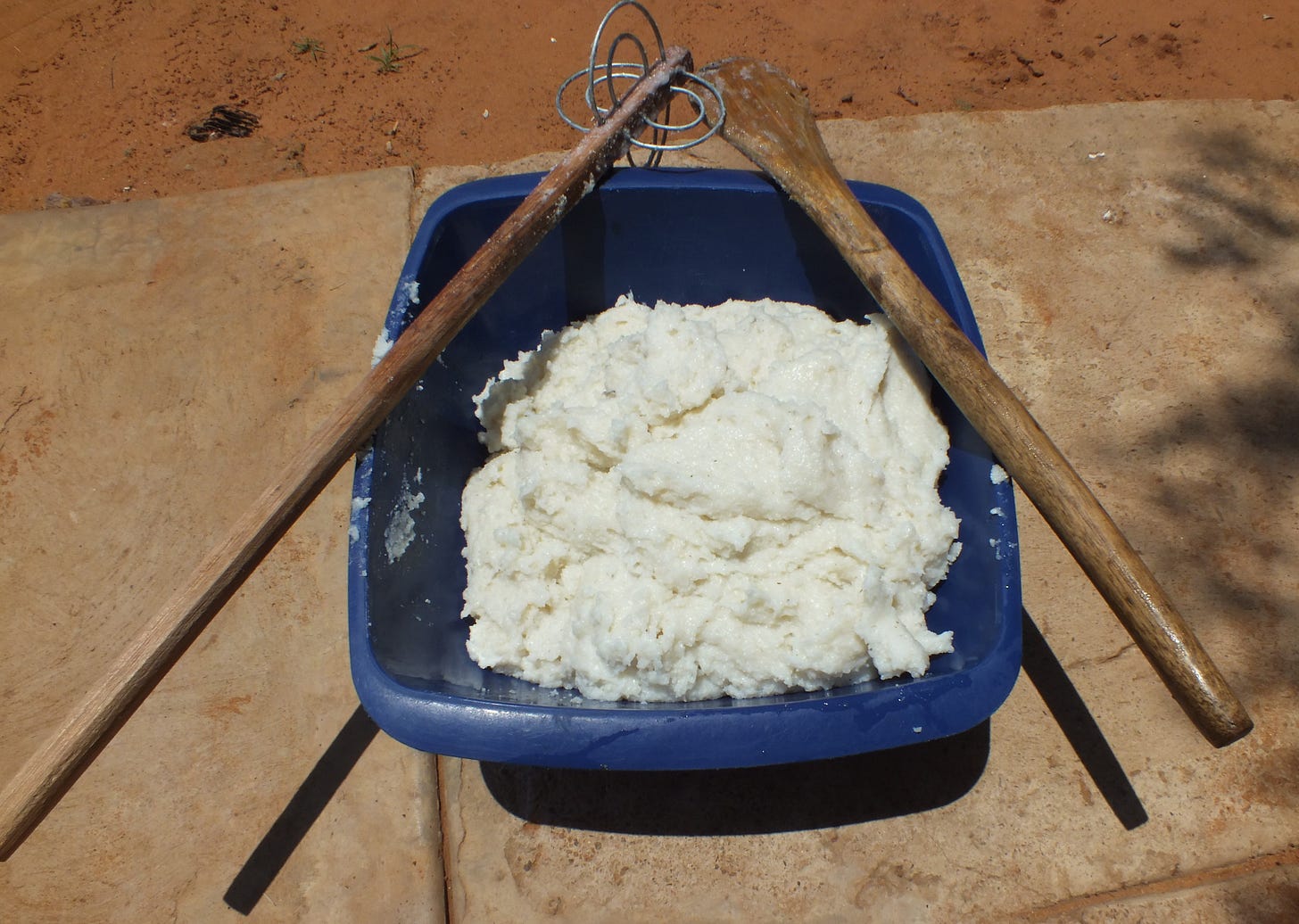

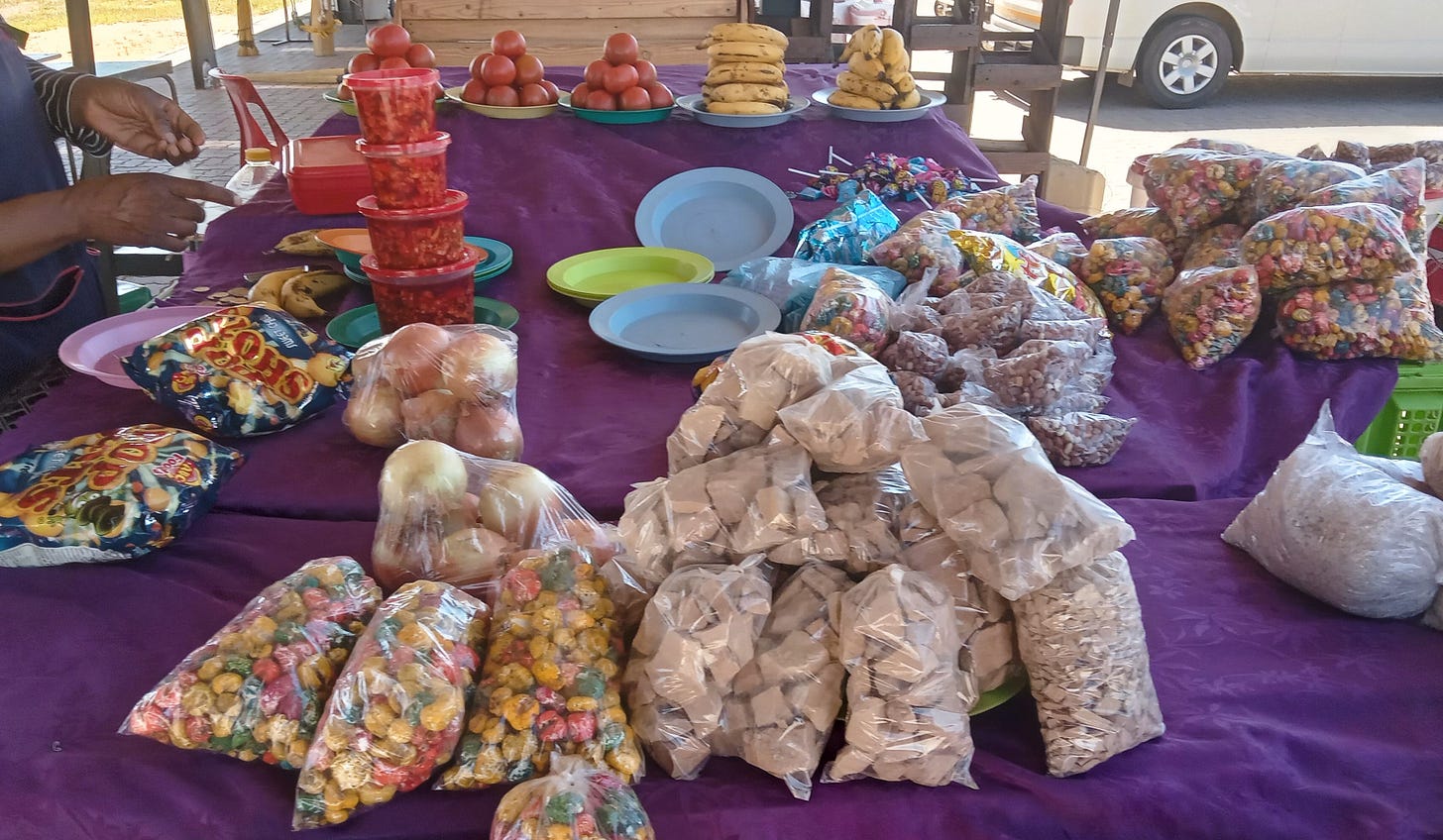


I love Laughing Cow Cheese - and I thought it was just a west african favorite! I don't think that stuff loses shape easily. Glad to see you eating so well.
Thumbs Up for the split pea soup. Thumbs Down for walking around with a bag of corn meal on your head.